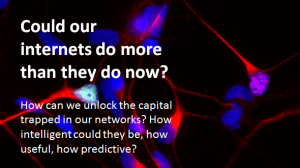The semantic web is just around the corner, but are we paying enough attention to intellectual capital vested in our intranets and internal networks?
For many organisations ‘sentient intranets’ may be a more valuable near term prospect than Big Data or the semantic web. Arguably, organisations have vested considerable intellectual capital in intranets that has never been fully exploited, ‘hidden’ intelligence that could dramatically improve performance and add value to a variety of stakeholders. Obviously, the key is to enable these networks and release stored capability and trapped value. While new technology clearly plays a role, other transformations are also required to make change stick and actually realise new, more prosperous ways of working.
Assessing capital value
As strategists reappraise capital investment in technology and existing proprietary networks, new ways of working more collaboratively enter the corporate vernacular. There has never been a better opportunity to re-design organisations intranet. But, it would be too easy to see these opportunities as just ways to save money through shifts toward ‘pay per click’, SaaS or cloud based services. There is much more potential and value to be generated from transition than simply providing more efficient processing platforms, better content management or slicker communications.
What needs to change
Collaboration and ideation technologies like Jive, Huddle, SocialCast, Spigit-Mindjet, HighQ, BrightIdea, provide platforms that make it easier for people to interact around key ideas, tactics and campaigns. And there are many more technologies and services to search more effectively, improve understanding, share knowledge and connect with customers and other external communities, but these few are enough to make the case. While these technologies provide a foundation to support new, more collaborative ways of working four things still need to change to help create sentient capability:
- Leadership
- Attitudes and behaviours of people
- Connection of key strategic processes
- Management of ‘intelligent insight’ and capabilities
There is, perhaps an inevitability about ecosystems that connect businesses, supply chains, staff and customers in new, more socially enabled ways. But, generating commercial benefit through collaboration may require attitudes and behaviours to change, not just in relation to technology but to embrace collaboration, more openness and transparency. Familiarity with social tools may be a first step, but to achieve persistent collaboration new frames of reference may be required. Operating models need to change from internalised ‘command and control’ to open collaboration and that is a ‘big ask’ for many businesses.
It’s a people thing
We all need to appreciate the vulnerability, value and responsibilities of working in openly collaborative ways. Attitudes and behaviours need to reflect new found individual responsibilities, self determining roles. We need to embrace explicit individual and group attitudinal and behavioural profiling, sharing and tracking of discussions, threads, sentiment, expression, meaning and stories. While some people embrace open, more collaborative work, it’s not for everyone. Key strategic processes will not see much benefit unless people want to, or a convinced that working in different ways has some kind of ‘pay off’ for them.
Connecting tissue
While new technologies enable collaborative working, they perhaps do little in fact, to really connect strategic processes. Without understanding the connecting tissue between strategic processes the DNA of many organisations can be easily misinterpreted. It’s a complex picture, a combination of leadership, culture, networks, processes, information and technology. Until we find smarter ways to decypher this, strategic processes will continue to cost more than they should and progress toward new forms of management and capital valuation will be slowed pending better understanding of what links such processes. Intelligent intranet is arguably achievable but some of it’s greatest value will be apparent when connections between strategic processes are clearer.
Intelligent insight around organisational capability is a reality that collaborative technologies can help deliver but they need to be smarter than they are today. Understanding in detail real time dynamics of change and transformation, interactions between people, work-styles and processes, sentiment and preference and momentum allows organisations to build holistic, integrated measures of capability, capacity and competence. Perhaps, organisations that can achieve this may well be the first to take the next few steps, building intelligent intranets, sentient networks able to reduce strategic risk by helping to manage complexity of collaboration at scale.
